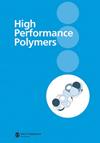Improved flame retardancy and smoke suppression properties of phenolic resin by incorporating MoO3 particles
IF 1.6
4区 化学
Q3 POLYMER SCIENCE
引用次数: 0
Abstract
Phenolic resin (PF) is widely used in aerospace, composite materials, and other fields. However, large amount of heat and smoke are produced during its combustion process, which is an important factor limiting its usage. To solve this problem, additive flame retardant MoO3 has been incorporated into PF for improving its flame retardancy and smoke suppression properties. Thermogravimetric analyses results show that the T5% of PF composites was gradually decreased from 264°C to 184°C and the char yield of PF-10% MoO3 is 57 wt.%, higher than that of neat PF (50 wt.%). The PF composites with 10 wt.% MoO3 passed UL-94 V-0 rating with a limiting oxygen index value of 29.8%. Meanwhile, the total heat release and total smoke production of PF-10% MoO3 are 37.60 MJ/m2 and 5.79 m2 respectively, which are reduced by 30.5% and 24.8% compared with neat PF. Only 10 wt.% MoO3 provide a 56.5% reduction (from 255 to 111) in maximal smoke density, meaning the good smoke suppression properties of MoO3. The pyrolysis products components are determined by thermogravimetric analysis combined with Fourier transform infrared spectroscopy. Furthermore, the micromorphology and chemical structure of char residue are also investigated by scanning electron microscopy, x-ray diffraction and Raman spectroscopy techniques. The promoting carbonization effect of MoO3 significantly reduces the heat release and toxic smoke production of PF composites.掺入MoO3颗粒改善酚醛树脂的阻燃抑烟性能
酚醛树脂(PF)广泛应用于航空航天、复合材料等领域。然而,在其燃烧过程中会产生大量的热量和烟雾,这是限制其使用的一个重要因素。为了解决这个问题,在PF中加入了添加剂阻燃剂MoO3,以提高其阻燃性和抑烟性能。热重分析结果表明,PF复合材料的T5%从264°C逐渐降低到184°C,PF-10%MoO3的焦炭产率为57 wt.%,高于纯PF(50 wt.%)。添加10 wt.%MoO3的PF复合材料通过了UL-94 V-0评级,极限氧指数值为29.8%。同时,PF-10%MoO3的总放热量和总产烟量分别为37.60MJ/m2和5.79m2,与纯PF相比分别降低了30.5%和24.8%。只有10wt.%MoO3的最大烟密度降低了56.5%(从255降低到111),这意味着MoO3具有良好的抑烟性能。通过热重分析结合傅立叶变换红外光谱测定热解产物的组分。此外,还利用扫描电子显微镜、x射线衍射和拉曼光谱技术研究了残炭的微观形貌和化学结构。MoO3的促进碳化作用显著降低了PF复合材料的热释放和有毒烟雾的产生。
本文章由计算机程序翻译,如有差异,请以英文原文为准。
求助全文
约1分钟内获得全文
求助全文
来源期刊

High Performance Polymers
化学-高分子科学
CiteScore
4.20
自引率
14.30%
发文量
106
审稿时长
1.2 months
期刊介绍:
Health Services Management Research (HSMR) is an authoritative international peer-reviewed journal which publishes theoretically and empirically rigorous research on questions of enduring interest to health-care organizations and systems throughout the world. Examining the real issues confronting health services management, it provides an independent view and cutting edge evidence-based research to guide policy-making and management decision-making. HSMR aims to be a forum serving an international community of academics and researchers on the one hand and healthcare managers, executives, policymakers and clinicians and all health professionals on the other. HSMR wants to make a substantial contribution to both research and managerial practice, with particular emphasis placed on publishing studies which offer actionable findings and on promoting knowledge mobilisation toward theoretical advances. All papers are expected to be of interest and relevance to an international audience. HSMR aims at enhance communication between academics and practitioners concerned with developing, implementing, and analysing health management issues, reforms and innovations primarily in European health systems and in all countries with developed health systems. Papers can report research undertaken in a single country, but they need to locate and explain their findings in an international context, and in international literature.
 求助内容:
求助内容: 应助结果提醒方式:
应助结果提醒方式:


